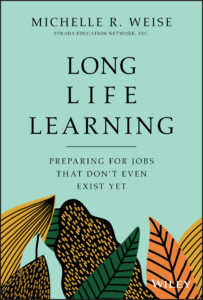The Future of Work
How long do you have until you retire? Are you nearing the end of your career or just starting out? What if careers lasted for 100 years? What if education lasted, not for four years, but for your entire lifetime?
That’s what Michelle R. Weise, Ph.D. predicts and prepares us for in her book, Long-Life Learning: Preparing for Jobs that Don’t Even Exist Yet. She argues that we need to change our thinking to prepare for a soon-to-arrive future. After reading her fascinating book, we discussed her thinking and research.
Before we begin, you worked with Clayton Christensen for a few years, and he had a profound influence on your work. Tell us more about how he influenced your thinking.
Clay’s theories of disruptive innovation gave me a compelling and constructive way to analyze innovations that are new and nascent, rather than dismiss or disparage them because they’re seemingly of a lower or different quality. I’ve learned that it’s precisely when we sense that very human reflex to reject that new idea that we might need to pay attention to this new thing because it might be just “good enough” (Clay’s words) to transform an industry.
How has the digital revolution, technology advancement, and automation, AI, etc. changed the workforce?
Technology has impacted nearly every facet of our economy. And these advancements will continue to give rise to entirely new kinds of jobs and careers, ones that we cannot even begin to name. It’s already been happening. In 2014, LinkedIn’s top jobs were ones that hadn’t existed five years earlier—roles like iOS/Android developer, UI/UX designer, cloud manager, big data architect, and social media intern. Artificial intelligence (AI), in particular, is infiltrating everything we do. Andrew Ng, the founder of the Google Brain Deep Learning Project, calls AI “the new electricity.” Just like electricity, AI will impact everything. So, what does this mean? We are all going to have to get into the business of preparing for jobs that don’t even exist yet.
Increasing lifespans led you to ask the question: Will a four-year education taken at the beginning of a 100-year career adequately prepare a worker for their entire life? I’m curious, even before longer lives, did it ever?
Yes, in fact, it used to be the case that even just a high school diploma could lead to great jobs with benefits and access to on-the-job training, as well as family-sustaining wages. Prior to the 1970s, the majority of high school grads went straight into the workforce, so those who went on to college effectively had an automatic ticket into the middle class.
Over the last few decades, however, the signaling power of a college degree has faded. More people go to college, and there are so many more colleges and universities in the country that are hard to differentiate from one another. So it works less well for employers to depend on the degree as a proxy for talent and capabilities. It’s a less useful sorting mechanism when there are now over 738,000 unique credentials flooding the education and labor markets. To exacerbate matters, the skills and knowledge needed to thrive in the labor market are changing at a pace and on a scale never before seen. More of us will have to pivot and acquire new skills over a longer and more turbulent work life. Even early baby boomers today are experiencing 12 job changes on average by the time they retire. The number of job transitions we can expect will only go up. And as things stand now, none of this is set up to be a seamless or easily navigable experience.
Most everyone will agree with the concept of lifelong learning, but not everyone actually lives it. What are some ways leaders can actively encourage it?
For all the talk of lifelong learning, educational and funding models remain antiquated. We can’t access many on- or off-ramps in and out of learning and work today. In fact, we often get penalized if we take one of those off-ramps. The opportunity ahead for leaders is to invest in the systems, architecture, and infrastructure needed to facilitate seamless movements in and out of learning and work.
For employers, in particular, this means looking within to cultivate their existing workforce and providing opportunities within the flow of work for their people to develop new skills for the jobs of the future. Organizations often do not carve out time for reskilling or upskilling. The expectation is that workers will somehow stack more training on top of all of the other demands in their lives. Time is the biggest barrier—the biggest point of friction when it comes to talent development—so it is critical for leaders to integrate learning opportunities into the workday, so workers can continue to earn a living while building new skills.
What are some of the major ways that worker education will be changing in the coming years?
We’re going to stop thinking of learning and work as separate activities, as if the workplace and the classroom are two distinct virtual or physical spaces. Instead, the upskilling pathways of the future will be hands-on and experiential. This is where advancements in augmented reality (AR), virtual reality (VR), and simulations show great promise. Companies like UPS, ExxonMobil, KFC, and BP are starting to turn to AR and VR to train people in digital skills more rapidly and in real time. Digital skills, in particular, are a pain point for companies because tens of millions of Americans have limited to no such skills. Walmart launched Walmart Academies to train 6,000 to 8,000 associates per week. At all 5,000 of its retail stores, workers engage in three- to five-minute modules on VR headsets and then practice those skills immediately on the sales floor.
But even more interesting is how some companies are leveraging immersive learning technologies for human skills development. Start-ups like Mursion offer scenario-based training for workers to rehearse, practice and improve their skills in managing conflict, negotiating, and delivering feedback in a low-stakes environment. We’ll be seeing more of this in the future—the blending of the classroom and the workplace as one and the same.
What advice do you have for those just graduating college?
Translation is key. You need to know how to market yourself and convey the skills you’ve acquired. Your unique experiences matter: Working on a long-term research project has clear linkages to project management, or a job at Target can be just as valuable as an internship at an investment bank. You have to be sure to translate what you’ve learned into the language of the labor market.
In addition, take some time to acquire some extra technical skills in areas like data analysis, graphic design, and social media. One Burning Glass study revealed eight technical skill sets can improve recent graduates’ employment and earnings potential. Taking the time to acquire such skills—whether in the workplace, through additional coursework, or by adding a minor—can make you more competitive or even open up new, and often higher-earning, occupations.
Your first job is critical. If you start out employed in a job that actually requires a college degree, it’s rare to slide into underemployment. But say you’re unable to land a bachelor’s-level job upon graduation, make sure that even that “compromise job” is in a field where there are other bachelor’s-level jobs to step up into over time. For example, recent graduates working as help desk technicians or as community health workers are twice as likely to recover and get back on track than those who start as servers in a restaurant or working grounds crew and landscape maintenance. Those first jobs matter.
How are these trends changing higher education? What changes do you see ahead?
Colleges and universities will no longer be able to rely on traditional demographics to fill their classrooms and residence halls. The overall number of high school graduates will plateau over the next decade. The good news is that there is a growing set of more mature learners who are eager to access just-in-time learning pathways. For many of those older learners, however, it’s difficult to fathom returning to college because they may not have been successful there the first time around.
For universities to thrive in the future—and the pandemic will likely force a noticeable contraction in the market—they will really need to evolve their models and tailor their programs to attract and meet the needs of this growing population of older adult learners. More mature learners won’t always be seeking a degree program. Most will need their education to be targeted, brief, and affordable—something they can complete in a short period to reduce time away from paid work and get them quickly into new, good jobs. The question for schools is: How will you engage differently with these learners to meet them where they are?
What is your perspective on COVID-19 in terms of your research, trends, and the future?
 Prior to COVID-19, we have to remember that we had more than 41 million working-age Americans who were seeking more direct connections to good jobs and good wages, but they kept falling through the cracks because of the limited way in which we train and hire our workforce. The situation of course became instantly bleaker when the pandemic hit because it forced millions of Americans, especially those in retail or hospitality jobs, to pivot to entirely new fields in search of employment. But businesses had not been engaging their existing employee base to address new and emerging forms of work. So to suddenly shift and somehow help newly laid-off or furloughed workers translate and transfer their skills to better-paying and more stable jobs in altogether different fields? It was a totally foreign concept.
Prior to COVID-19, we have to remember that we had more than 41 million working-age Americans who were seeking more direct connections to good jobs and good wages, but they kept falling through the cracks because of the limited way in which we train and hire our workforce. The situation of course became instantly bleaker when the pandemic hit because it forced millions of Americans, especially those in retail or hospitality jobs, to pivot to entirely new fields in search of employment. But businesses had not been engaging their existing employee base to address new and emerging forms of work. So to suddenly shift and somehow help newly laid-off or furloughed workers translate and transfer their skills to better-paying and more stable jobs in altogether different fields? It was a totally foreign concept.
COVID laid bare how fragile our multiple, fragmented systems of K–12 education, postsecondary education, and workforce training are. To do better, we must invest in the infrastructure of a new learning ecosystem that centers on all of us as job seekers so that we can access the relevant information, funding, advising, support, and skills training we need in order to navigate the many more job changes to come.
For more information, see Long-Life Learning: Preparing for Jobs that Don’t Even Exist Yet.
Image Credit: Tim Mossholder

